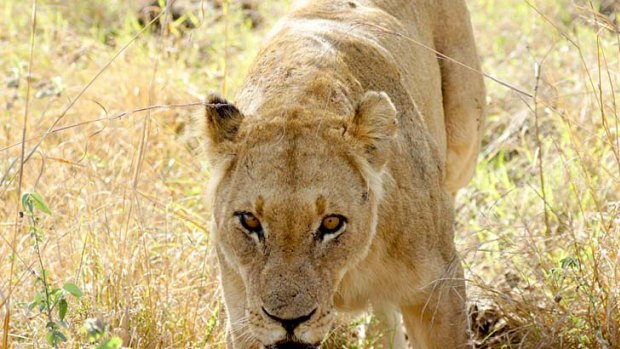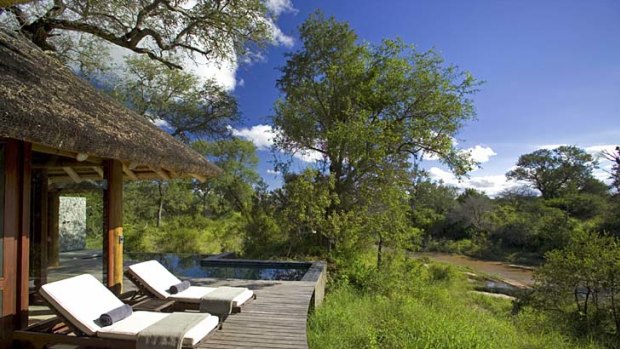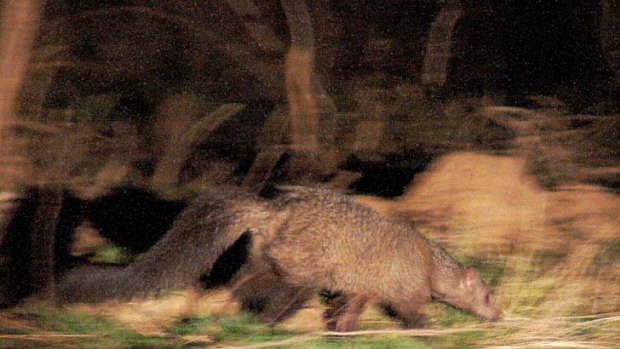Seeing dangerous animals in the wild is a heart-warming experience, unless they're staring back at you, writes Craig Platt.
I'm so glad I asked for a toilet stop, otherwise I'd be in real trouble.
I'm being stared down by a huge lioness, who is only a few metres away. If she wanted to, she could be up on the back of this safari vehicle and eating my liver in a matter of seconds.

Scarily close ... stared down by a lion.Credit: Craig Platt
Fortunately she holds my gaze for just a brief moment (though it feels like an eternity) before walking on behind the truck. I take a deep breath and, for some reason, exclaim an odd “holy moly” when, really, a more profane expletive was called for.
A few minutes earlier, we were on our way to see a large pride of lions here in South Africa's Sabi Sands Game Reserve. The private collection of reserves borders the vast Kruger National Park and the animals come and go as they please. They're as wild as they come, but are quite used to seeing tourists driving around in Land Cruisers and generally ignore them.
But while the tourists and animals don't tend to bother one another, there are certain rules to follow when you're on safari. When in the presence of animals, you should try to avoid making loud noises, but more importantly you don't stand up in the vehicle – ever - and it goes without saying that you don't get out of the vehicle. The animals tend not to associate cars with people – unless you stand up and make it obvious you're in there. If you do that, you might scare them off … or you might become lunch.

Luxury in the wild ... Leadwood Lodge.
For this reason I knew if I wanted to stop for a toilet break out here in the bush, it had to be before we reached the lions, because there would be no getting out to relieve myself once we entered their neighbourhood. We'd been up since 5am (the best viewing times for animals are at dawn and dusk) and I'd been swilling cups of tea all morning. My bladder was fit to burst.
So at my request we pulled up and I jumped off the vehicle to head behind a nearby tree. My fellow tourists also climbed out. However, just as I was midstream, as it were, our driver Mark called out: “Craig, you've got to nip that and get back on the vehicle right now!”
I saw the others running – running! - back to the car. It turned out one of the lions had broken off from the rest of the group and was within sight of us. I quickly zipped up and jumped back on.

Shot on the run ... the rarely seen - or photographed - Meller's mongoose.Credit: Craig Platt
Shortly after, the lioness came strolling by in the nonchalant way that only the king (or queen) of the jungle can. I snapped away at her through my camera's zoom lens, until eventually noticing through the viewfinder that she seemed to be getting extremely close. I took the camera away from my eye and I found her staring up at me, just a couple of metres away and closer than anything I'd seen so far on the trip. My heart raced and I was glad my bladder had been emptied.
Lions are just one of the attractions in the Sabi Sands, which is home to a vast array of wildlife, including South Africa's famed “Big Five” – lions, leopards, rhinos, elephants and buffaloes.
Some guides shun the “Big Five” expression though, pointing out that it has its origins in hunting, not tourism. The “Big Five” are the five most dangerous animals to hunt on foot, not the rarest or largest (which is why giraffes are missing).
Sabi Sands is home to the big five and plenty more besides.
Though cheetahs are not generally found here, it is said to be the best place in South Africa to see the elusive leopard (incredibly, we see four on our first evening, including a mother and her sub-adult son who kindly climb to the top a termite mound to pose for us).
There are a variety of luxury lodges in the area (including one owned by Richard Branson) and some of them make a mockery of the idea of 'roughing it' in the African wilderness.
Luxury tour operator &Beyond operates several, including the extraordinary Leadwood Lodge. With just four suites, Leadwood can accommodate just eight guests, each couple getting their own private lodge with plunge pool, a deck and both indoor and outdoor showers. There's no TV, but if you want to watch television here, you're wasting the trip. Situated next to a dry river bed, all the entertainment you need can be had by simply looking out the window.
Meals are included and it feels like any time we're not on safari, we're eating. There's hot drinks and muffins at the 5am wake-up, snacks during the morning safari, then a return to the lodge for a full breakfast in the late morning. Then there's lunch, afternoon tea, another safari with snacks and a full range of alcoholic beverages for the famed South African "sundowner", then back to the lodge for a three course meal.
The only caveat is that you must lock – not just close – your doors out here. Local baboons like a taste of luxury themselves and will raid your room for nibbles if they can (fortunately they are quite scared of humans so only try to enter when there's no one around).
By the standards of the region, baboons are small beer as far as dangers are concerned. At the lodges, we're not allowed to approach our rooms after dark without a guide, lest a big cat or elephant has wandered into unfenced grounds.
Over three days in the region, we get to witness just how deadly some of these animals can be. While we aren't on hand to witness a kill, we do come across the aftermath of several unusual hunts.
A pair of lionesses have killed a young giraffe and take several days to eat it with their three cubs - when you're not being stared down by them, lions are incredibly cute. But as cute as the little ones are, it's also heartbreaking to find that, as we watch from our vehicle, the giraffe's mother returns to see what has become of her offspring. We're told she's been back every morning since the youngster was killed.
Another sad death is that of a rhino, which, undiscovered by the big cats, is providing sustenance for a cackle of hyenas (yes, that's apparently their collective noun). Once a rhino is full-grown, there's virtually nothing in the wild that can kill it – except another rhino, and that's what's happened here. Unlike rhinos one sees in the zoo with their ground-down horns, these beasts sport long, sharp weapons on their noses. Our ranger expresses his frustration at the death – the animals are endangered, yet they're killing each other.
On each safari drive we're accompanied by one of the lodge's rangers and a tracker, who displays uncanny skill at finding animals. One morning we pull up at a word from our tracker on a dirt road. He leaps down and, in a display reminiscent of something straight out of an adventure movie, says that the small swirl of lines in the sand represent a leopard's kill. A few seconds later and he's gone into the scrub and found the remains of a furry, skunk-like creature – and spotted the leopard running off. It's a civet, an animal somewhere between a cat and a mongoose and another unusual kill – civets offer little meat and too much fur for big cats; normally they won't bother with them.
But along with the frustration of seeing these rare animals killed, the rangers also experience elation. While lions, elephants, rhinos and even leopards are reasonably commonplace sights for the rangers, occasionally there is something that excites them. When driving back to the lodge one evening, Mark shouts in excitement as a small, furry animal crosses in the headlights in front of us.
“It's a Meller's mongoose! Quick, someone get a picture!” he exclaims.
Unprepared for this last-minute sighting, I struggle to get my camera switched on and fire off a few shots. They're blurry in the poor light, but Mark is thrilled nonetheless and asks me to share the photos with him.
He shows me why he's so excited by pointing out a photo of the mongoose in his wildlife guide – it's so rare, the only picture the book has is of a pelt (later, at the lodge, we find a search on Google Images for Meller's mongoose brings up only pictures of other mongoose species or "artists' impressions").
His excitement is infectious and after we return to the lodge we are proudly bragging about our sighting to the other guests. It's a nice example of the magic of seeing these magnificent animals in the wild. Even for those who do it twice a day, every day, it's still thrilling.
The writer travelled as a guest of South Africa Airways and South Africa Tourism.
Fast Facts
Getting there
South Africa Airways flies 13 times flights a week from Sydney and Perth direct to Johannesburg. Return fares start at $2079 from Sydney and $1970 from Perth. See www.flysaa.com or phone 1300 435 972. Air transfers from Johannesburg to the Sabi Sands lodges can be arranged through &Beyond via Federal Air, starting from 5520 rand (about $A660) return.
Staying there
&Beyond has several lodges in the Sabi Sands. All listed below include two daily safari drives and all meals, plus morning and afternoon tea and beer, wine and basic spirits.
Leadwood Lodge sits on the edge of the Sand River and features just four individual lodges, each featuring air conditioning, a fireplace, sitting room, private pool, a wooden deck, bath and indoor and outdoor showers. Rates from 5995 rand ($A728) per person, per night, low season. See the lodge website for more details.
Dulini Lodge is on the banks of the seasonal Mabrak River and offers similar accommodation (with marginally smaller rooms) to Leadwood across its six individual lodges, including air conditioning, plunge pools, indoor and outdoor showers and wooden decks. Rates from 4850 rand ($590) per person, per night, low season. See the lodge website for more details
Kirkman's Kamp is the historic homestead of former ranger Harry Kirkman, built in the 1920s. Kirkman's is larger facility than the other &Beyond lodges with 18 suites around the colonial central building. Kirkman's offers triple-bed accommodation for families. Rooms from 4195 rand ($A510) per person, per night, low season. See the lodge website for more details.
On safari
The best wildlife viewing in Sabi Sands is from March to October.
Children under five are not allowed on game drives. Children age six to 11 can participate in game drives at the lodge manager's discretion.
The rules to follow on game drives are fairly simple – obey your ranger. Don't stand up, don't get out of the vehicle and don't do anything to disturb the animals.
Follow the Traveller section on Twitter @FairfaxTravel
Sign up for the Traveller Deals newsletter
Get exclusive travel deals delivered straight to your inbox. Sign up now.